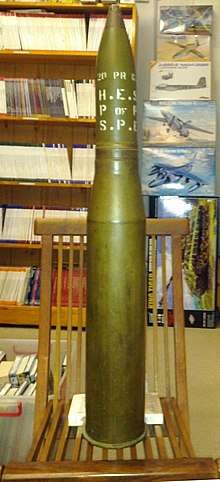Ordnance QF 20-pounder
The Ordnance QF 20 pounder (known as 20 pounder, 20 pdr or simply 20-pr) was a British 84 mm (3.307 inch) tank gun.[1][lower-roman 1] It was introduced in 1948 and used in the Centurion main battle tank, Charioteer medium tank, and Caernarvon Mark II heavy tank. The 20 pounder was designed to replace the Ordnance QF 17 pounder, which had proven itself effective in World War II. However, once the 20 pounder gun was found to have inadequate performance against the Soviet T-54, the gun was mostly replaced in service by the larger calibre 105 mm L7 gun.
| Ordnance QF 20 pounder Mark I | |
|---|---|
 Charioteer tank equipped with the 20 pounder. This gun is a later model which is fitted with a bore evacuator | |
| Type | tank gun |
| Place of origin | United Kingdom |
| Service history | |
| In service | 1948–1970s |
| Used by | United Kingdom Australia Austria Canada Finland Israel Jordan Lebanon South Africa |
| Wars | Korean War Vietnam War Six-Day War South African Border War |
| Specifications | |
| Length | 226.4 in (5.75 m), 66.7 calibres |
| Shell | 84×618mm R |
| Calibre | 84 millimetres (3.31 in) |
| Elevation | +18 to −10 in Centurion Mk 5 |
Design and development
The gun was developed by the Royal Ordnance Factories.
As fitted to the Charioteer, it ran through two models:
- Model A without a fume extractor.
- Model B with a fume extractor.
The L7 105 mm tank gun was developed from the 20 pounder. In 1954, the original version of the 105 mm was made by re-boring the tube of a 20 pounder barrel.[2]
Service history
The gun was fitted predominantly to the Centurion tank, seeing action with British and Australian forces during the Korean and Vietnam War. When a Soviet T-54A main battle tank was driven to the British embassy in Budapest by Hungarian rebels during the Hungarian Revolution of 1956, analysis of its armour and 100 mm gun led British officials to determine that the 20 pounder was ineffective at defeating Soviet armour. This led to the development of the 105 mm L7 tank gun, which was designed to fit specifically into the turret mountings of the 20 pounder, facilitating for easily upgunning existing tanks equipped with the 20 pounder.[3]
One 20 pounder gun was fitted to a Swiss pre-production Panzer 58, replacing a domestic 90 mm Kanone 1948 gun, before it was equipped with the 105 mm L7.[4]
Performance
The 20 pounder's APCBC projectile had an initial muzzle velocity of 1,020 metres per second and could penetrate 210 mm (8.3 in) of rolled homogeneous armour (RHA). However, these conventional rounds were rarely used.
The APDS projectile had a muzzle velocity of 1,465 m/s (4,810 ft/s) and the APDS Mk.3 shell could penetrate 330 mm (13 in) of RHA at a distance of 1000 yards, and 290 mm (11 in) of penetration at 2000 yards, equating to a line of sight penetration of 330 mm and 290 mm respectively.[5][lower-roman 2] Against sloped armour, the APDS had reduced effectiveness: penetrating 87 mm (3.4 in) and 77 mm (3.0 in) of RHA at 1,000 yd (910 m) and 2,000 yd (1,800 m) respectively, against a plate angled 60 degrees from the normal, this is only 174 mm (6.9 in), and 154 mm (6.1 in) of line of sight penetration.[6] At given ranges, the 20 pounder APDS Mk. III shot only had 53% of its line of sight penetration against a sloped plate, compared to at the normal. Line of sight penetration refers to a flat line drawn through a piece of sloped armour, indicating the effective thickness.
The 20-pounder could also fire high-explosive and canister shot shells.
Ammunition

| Round | Muzzle velocity[7] |
|---|---|
| APDS | 4,700 ft/s |
| HE | 1,975 ft/s |
| Canister | 3,000 ft/s |
| Smoke | 825 ft/s |
Footnotes
Notes
- The gun is specified as 83.4 mm (3.283 in) here, while Ogorkiewiecz states the weapon was 83.8 mm. Norman gives it as "3.3 inch (84 mm)"
- The 20 pounder's APDS round had twice the penetration capability of an KwK 36 8.8 cm AP round.
References
- Pugh (1962), p. 34.
- Ogorkiewicz (1991), p. 70.
- Zaloga, Steve, 1952- (2004). T-54 and T-55 main battle tanks 1944-2004. Johnson, Hugh, 1971-. Oxford: Osprey. ISBN 1841767921. OCLC 60834392.CS1 maint: multiple names: authors list (link)
- Ford (1997), p. 121.
- Dunstan (2003), p. 10.
- British Army Operational Research Group (June 1954), Memorandum E.13 Tank Effectiveness: Conqueror, Conway and Charioteer, p. 9 – via Archive.org
- Norman (1967), p. 12.
Bibliography
- "Tank Effectiveness: Conqueror, Conway and Charioteer". opensource, p. 9. British Army Operational Research Group.
- Dunstan, Simon (2003). Centurion Universal Tank 1943-2003. Oxford, UK: Osprey Publishing. ISBN 1-84176-387-X.CS1 maint: ref=harv (link).
- Ford, Roger (1997). The World's Great Tanks from 1916 to the present day. Brown Packaging Books Ltd. ISBN 1-897884-29-X.CS1 maint: ref=harv (link)
- Norman, Michael (1967). Armour in Profile (Number 23), Centurion 5. Surrey: Profile Publications Ltd.CS1 maint: ref=harv (link)
- Ogorkiewicz, Richard (1991). Technology of Tanks. London, UK: Jane's Information Group, Ltd. ISBN 0-7106-0595-1.CS1 maint: ref=harv (link).
- Pugh, Stevenson (1962). Fighting Vehicles and Weapons of the Modern British Army. Macdonald & Co. OCLC 10010960.CS1 maint: ref=harv (link)
See also
External links
| Wikimedia Commons has media related to QF 20 pounder. |